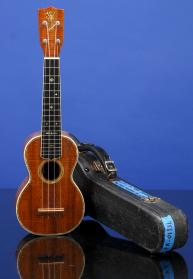"The Bouncing Flea".
This super rare Martin 5K Ukulele weighs less than one pound. The length of the body is 9 1/4 inches, the width is 6 1/8 inches and the depth is 2 1/8 inches. The top, back and sides are Hawaiian Koa The top and back of the instrument feature an elaborate seven-ply binding of white and black ivory celluloid and a band of mother-of-pearl. The sound-hole has an eight-ply ring of white and black ivory celluloid and mother-of-pearl. One-piece mahogany neck with a scale length of 13 3/4 inches, a nut width of 1 3/8 inches and a medium neck profile. Koa peghead veneer with pearl inlaid 'flowerpot' scroll. Four individual 'friction' pegs with oval ivory buttons. Ivory celluloid bound ebony fretboard with seventeen original thin frets and elaborate pearl position markers. Fixed Hawaiian Koa tailpiece with bone bridge saddle. On the fifth fret , one of the shaped pearl inlays is missing, as is a tiny piece of pearl from the bass waist on the top. There is some light surface wear on the treble side by the neck (just where you would expect it!) otherwise this nearly ninety year old, top-of-the-line Ukulele is in exceptionally fine (9.00) condition. The number "21G552" is stamped into the treble top-edge of the headstock. Housed in it's original Martin 'Violin' style three-latch shaped black hardshell case with padded purple felt lining (9.00).
We date this rare Ukulele as 1922. According to Mike Longworth's reference book on Martin instruments, the original 'friction' tuning pegs (as on this example) were replaced in 1923 with 'Patent' tuning pegs. It is unusual to find one of these in all original condition without any repaired grain cracks.
"Koa is a native wood of Hawaii. For many years it was very popular for use in making ukuleles. These ukuleles were listed in the catalog with a K suffix to the style. They were identical to the regular ukes in size and trimmings, the only change being the substitution of koa wood. (Longworth, p.94).
In 1916, recordings of Hawaiian music outsold all other styles, and Martin, with their usual high standards of quality, began to manufacture ukuleles. By the 1920s and '30s, sales of their ukes rivaled that of their guitars, and helped Martin weather the Depression.
Their basic model, Style O, was a simple, plain affair. With Style 5, however, Martin pulled out the stops. It featured a highly figured Hawaiian Koa body with abalone trim on the top and back, an ebony fingerboard with ivory celluloid binding, snowflake abalone inlays, and an unbound peghead with a Hawaiian Koa wood veneer and an abalone torch pattern inlay.
"The style 5 was the most deluxe model in the Martin ukulele line, and is the most rare today. As is typical of most instruments, when the original list price is higher, quantity sold will be lower. The style 0, which listed at $10 to $12 in the 1920s and ’30s, sold in vastly greater quantities than the style 5, at a list price of $50 to $55. While these prices may seem absurdly cheap by modern standards, in order to convert prices of the Depression era to the equivalent amount in today’s dollars, one must multiply by 25 to 30. Even so, in view of the fact that a clean original 5K will today sell for nearly $10,000, the original price seems like a great bargain" (George Gruhn. Martin 5K, Vintage Guitar Magazine, April, 2005).








